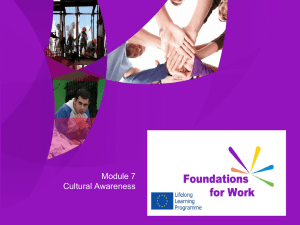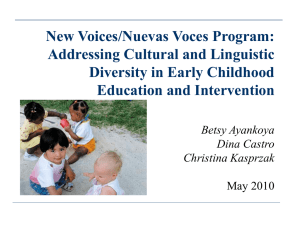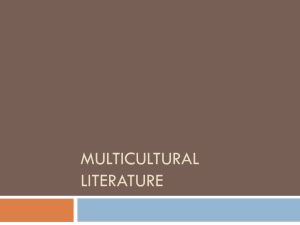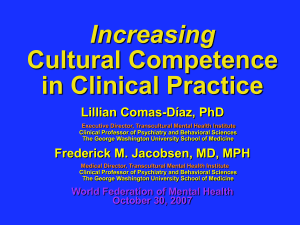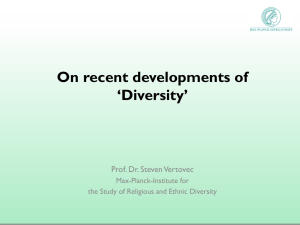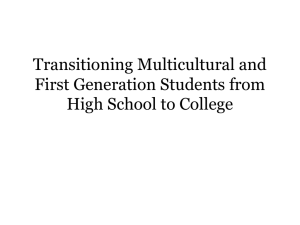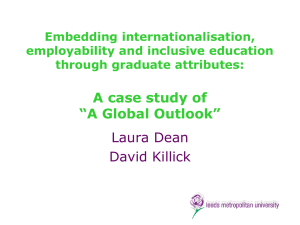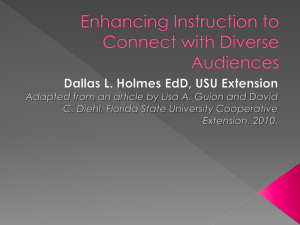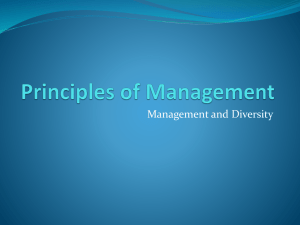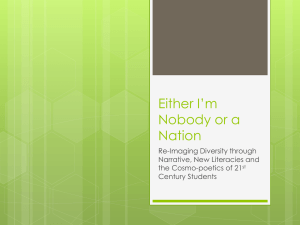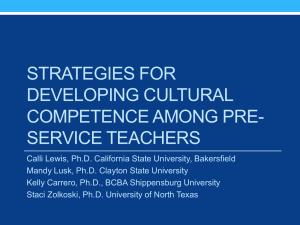Multicultural Education - U-System
advertisement
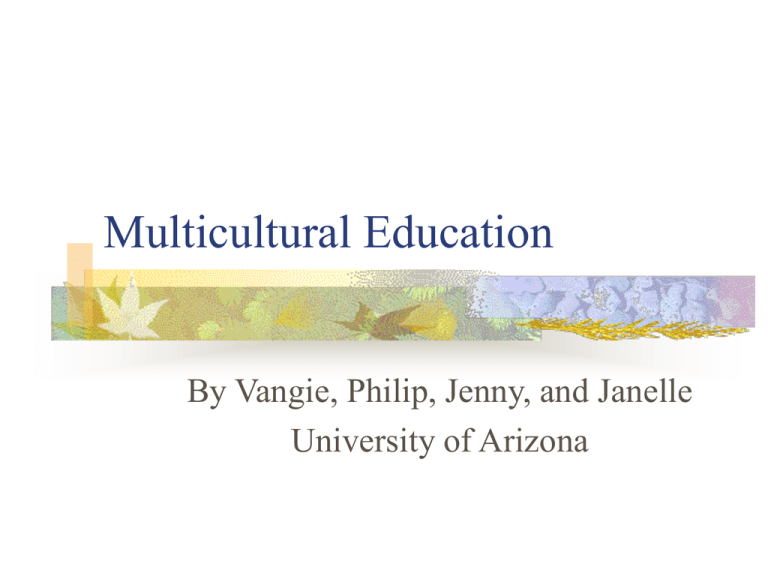
Multicultural Education By Vangie, Philip, Jenny, and Janelle University of Arizona Why do we need multicultural education? Jim Cummins (3) writes, “In many societies throughout the world, students who experience the most persistent and severe educational difficulties tend to come from communities that, over generations, have been discriminated against and viewed as inherently inferior by the dominant societal group… Why do we need multicultural education? …Schools reflect the values and attitudes of the broader society that supports them and so it is hardly surprising that in the United States students from African American, Latino/Latina, and Native American communities have experienced extensive devaluation of their cultures and languages within the school context.” What is multicultural education? Complex program Encourages critical thought Affirms student identity Develops cultural competence Highlights different perspectives Builds on student strengths Sets high expectations What are the goals of multicultural education? Educational equity Empowerment Cultural pluralism Intercultural/interethnic/ intergroup understanding Freedom Expanded knowledge Informed and inquisitive multicultural perspective What are some objections to multicultural education? Revisionist approach to history Emphasis on group achievement over individual success Anti-assimilationist What are some criticisms of multicultural education? Poorly planned or incomplete programs… Essentialize different cultures Supplemental “tourist” curriculum Promote tolerance over transformation Tolerance vs. Transformation Prejudice is individual Facts and interaction will help Multicultural education only for minority students Holidays and food “Other” cultures Appreciation, enjoyment, and tolerance Prejudice institutional as well as interpersonal Racism means of control Anti-bias education for all students Communities involved with curriculum and everyday activities Self-identity Empathy for others How can we apply multicultural education’s guiding principles? Systemic level Power, influence, and authority Connections with race/ethnicity Factors in decision-making Reforms to deep structure Teacher training and recruitment De-tracking What Native Schools and School leaders can do Educate teachers Ensure ongoing support on Native American history on community issues Matching white teachers with supportive & knowledgeable tribal leaders Mentoring processes should be detailed and rigorously implemented Create a culture of safety Necessary components for success Deep support from local community Funding Leadership Thoughtful and open dialogue Culturally Appropriate Schools Increased relevance Need for balance Difficult to teach Native children when teachers know little about the history, culture, and communities in which they teach Culture, Community, & Education Emphasize community, culture, and tradition Native beliefs and value systems Acculturation—blending traditional values & principles with current & appropriate educational concepts, technologies and content Applying what they learn in the classroom to the communities in which they live Studies supporting culturally linked school programs How can we apply multicultural education’s guiding principles? Practical level Curriculum Teaching strategies Materials Areas to Inventory Vision, planning, and school improvement Administrative leadership Parents and community School wide behavioral climate and policies Instructional practices Assessment Professional development Facilities Resources How can we develop a multicultural curriculum? Challenge the hidden curriculum Knowledge and experience of students Diversity and complexity Politics of possibility and hope Teach topics within context Culturally Appropriate Curriculum Experience world through culture Experience school through culturally sensitive lens Cannot separate school culture from our own culture How can we develop multicultural teaching strategies? Cooperative, active learning Variety of instructional methods Multiple perspectives Intercultural/bilingual education High expectations Integrated units Student and collective agency Lessons from the Maori Good teaching has a positive effect on the psychological, socio-cultural, and sociolinguistic development of the student. Rules of practice Practical principles Images What White Teachers can do to Strengthen Native Learning Find mentors Get educated Know and participate in the community Question personal knowledge of historical “facts” Create materials Expect measured success Push for training Classroom Environment: What we do know Most native children learn best when hands-on, experiential teaching & learning approaches are used. A positive relationship exists between students’ academic learning and their strong sense of cultural identity. Informal and flexible learning environments How can we best use materials for multicultural education? Check all materials for bias Variety of materials Variety of sources Teacher, student, or community-created materials Explicitly discuss differences Difficulties of Implementation Mismatch between NCLB programs and the research base on Native American learning Conclusion The benefits of establishing multicultural education can be great; as described by Manu’atu (p. 9), “The learning environment becomes familiar to all the participants. Using [students’] ways of communicating and representing the world means establishing a situation that enables meaningful communication between the student and the context, the text, the tutor and the student, the student and the other students, the students and parents. Besides, including the [students’] personal lived experiences in the educative process brings forth their apprehension of subject-content under study.” Sources Airini (1998). What Is Good Teaching? Lessons from Maori Pedagogy. ERIC Document Number ED427917. Cummins, Jim. Negotiating identities: Education for empowerment in a diverse society. Ontario: California Association for Bilingual Education, 1996. Davidman, Leonard; Davidman, Patricia. Teaching with a multicultural perspective: A practical guide. New York: Longman Publishers, 1997. Lee, Enid; Menkart, Deborah; Okazawa-Rey, Margo, eds. Beyond Heroes and Holidays: A practical guide to K-12 anti-racist, multicultural education and staff development. Washington, D.C.: Network of Educators on the Americas, 1998. Sources Learn-Ed Nations Inventory, A Tool for Improving Schools with American Indian and Alaska Native Students published by the Northwest Regional Educational Laboratory, 2002. Manu'atu, Linita; Kepa, Mere (2001). A Critical Theory to Teaching English to Speakers of Other Languages (TESOL): The Promising Focus for Indigenous Perspectives. ERIC Document Number ED465273. Starnes, B. (2006). What we don’t know can hurt them: White teachers, Indian children. Phi Delta Kappan, 87, 384-392. Yazzie, Tarajean (1999). Culturally Appropriate Curriculum: A Research Based Rationale. ERIC Document Number ED427906.
